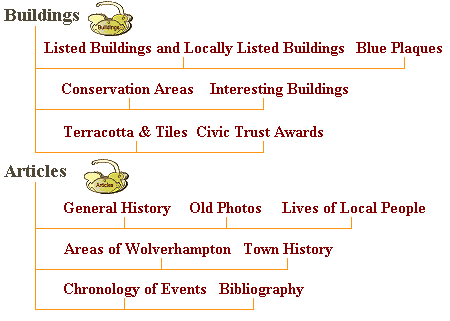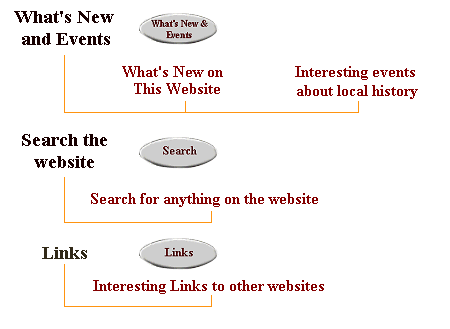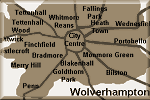|
A Guide to
Using the Website
The guide is divided into three parts:
1. Finding
your way around the website.
2. Where is Wolverhampton
and the Black Country?
3.
All about the website.
1. Finding your
way around the website.
It can sometimes be difficult finding a topic on
such a large website as this and so we have prepared a simple
graphic guide to help you to locate the area in which you are
interested. The website is divided into a number of sections,
each covering an individual topic that is related to our
past or to the society. Each section is accessed by clicking on
one of the locks or buttons on the front page. This will take
you to a main menu that may contain other sub menus, all listing
articles that are related to the same topic.
The website layout
To access any of the sections on the diagrams below just click
on them.





2. Where is
Wolverhampton and the Black Country?
This section is especially for our overseas
readers. The Black Country, consisting of Wolverhampton,
Walsall, Dudley, and Sandwell lies on the edge of the West
Midlands, a large, mainly urban area, stretching across to
Birmingham and Coventry in the south east.
 |
View a map
showing the location of Wolverhampton and the Black
Country |
The Black Country is named after the extensive
industrialisation that once covered much of
the area and was one of the country's most important
manufacturing centres. Coal, iron ore and limestone were in
plentiful supply, and so with the raw ingredients in place, an
iron and steel industry rapidly developed.
Almost anything that could be made from iron or steel
was produced in the area. The southern part around Cradley
concentrated on the production of nails and chains, whereas
Walsall to the north was the centre of the leather goods
industry. Willenhall became famous for locks and Darlaston had
the country's largest nut and bolt makers. Most of the towns
manufactured almost anything that
could be made from metal. It is easier to make a list of what
wasn't made here rather than what was.
Everything has changed today, the industrial era
in the Black Country is almost at an end. A century ago most
people worked in industry whereas today very few choose to do
so. The area is much cleaner than it has been for several
hundred years. St. Peter's Church in the centre of Wolverhampton
offers a marvellous view of the Black Country from the top of
its tower. If you went there forty years ago and looked towards
rural Shropshire to the west, everything was green and lush,
whereas to the east it was grey and murky. If you do this today
the view is very similar in both directions. The old industrial
areas are now clean and large numbers of trees have been
planted.
Black Country people are proud of their
industrial heritage and some has been preserved in local
museums. Unfortunately much has been lost and much of what
remains is rapidly disappearing. On the website is our virtual
museum and we include displays and information on our industrial
past in an attempt to record much of our recent history before
it is lost forever.
3. All about the
website.
This site should display correctly on most browsers such
as Internet Explorer, Flock, and Firefox. It has been optimised for a PC with a screen
resolution of 800 x 600 and above.
All comments on the site, all responses and feedback,
and all notifications of errors, broken links, etc., will be gratefully
received by the webmaster.
This site contains material about Wolverhampton's history and
heritage, and Black Country towns It is hoped that it will turn into an
exercise in interactive co-operative writing and become a focus for those who
know something about, or are finding out something about Wolverhampton and the
surrounding area's history and heritage.
We also want to make it useful for schools. We continue in the increasingly
desperate hope that one day someone will deliver on successive governments'
promises to make computers and the Internet fully available in all schools. In
the meantime kids might be able to access this site from home.
And we also try to bear in mind that people from outside the area might want
to find out something about Wolverhampton's background and could find some of
the stuff useful. We also know that many ex-Wulfrunians or people of
Wulfrunian ancestry find the site interesting and we like to think we can cater
for them as well.
How
Web sites often contain information about how they were produced. Goodness
knows why. But just in case anyone is interested, here goes:
This site was originally produced in 1999 using a Roldec computer with a Pentium II
chip, running Microsoft's FrontPage web authoring software. Roldec was
Wolverhampton's biggest, and only nationwide computer maker; it went bankrupt
rather suddenly. So much for supporting local industry.
The website is still produced with FrontPage, and a host of
graphics and photo editing software including Photoshop, Paint
Shop Pro, and Coreldraw. The navigation buttons etc. use
Javascript, which is added where necessary. Since 2000 it has
been on one of Wolverhampton University's servers, as part
of their community programme. Late in 2012 it was discovered that they are
no longer happy with it being there, so it has now been moved to
a BT server.
The site is designed to download quickly and to be simple to use and easy to
navigate. Some of the photographs, the ones that have been on the site since the
early years are a little small, simply because in those days broadband was not
readily available, and most people used dial-up modems. Larger photos would
have taken an extremely long time to download.
You won't find any
of those irritating notices telling you to download some odd bit of software
before you can carry on using the site, which doesn't suffer from banners or pop-up windows.
I hope you will enjoy your visit, and any future visits to
the site.
Bev Parker
|